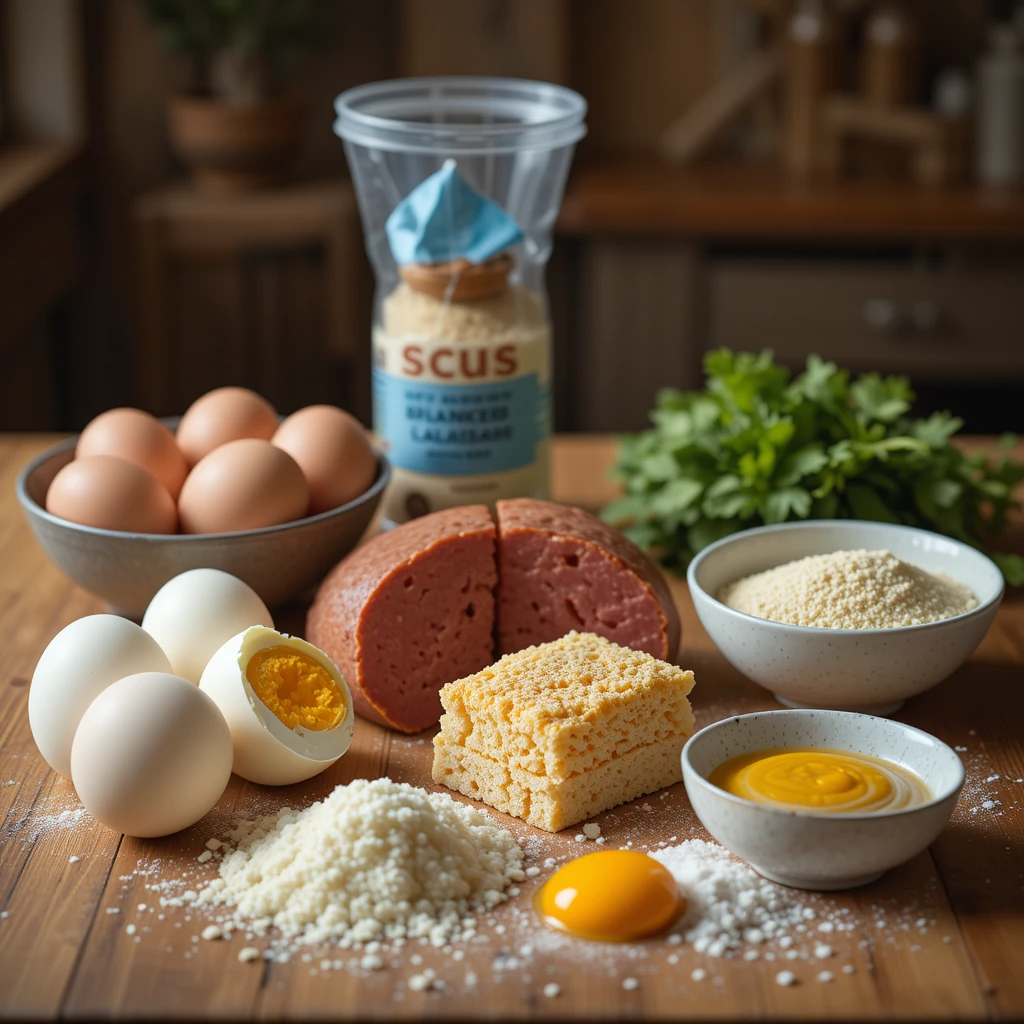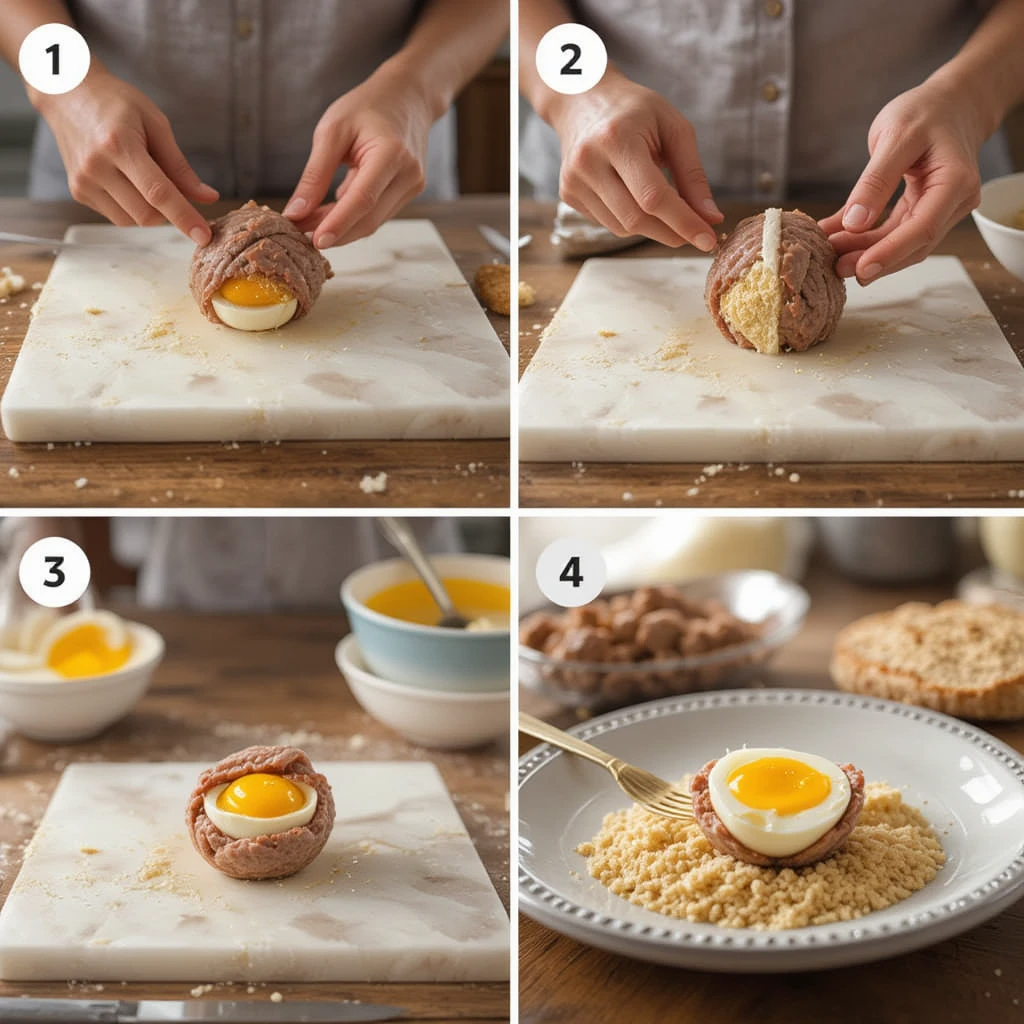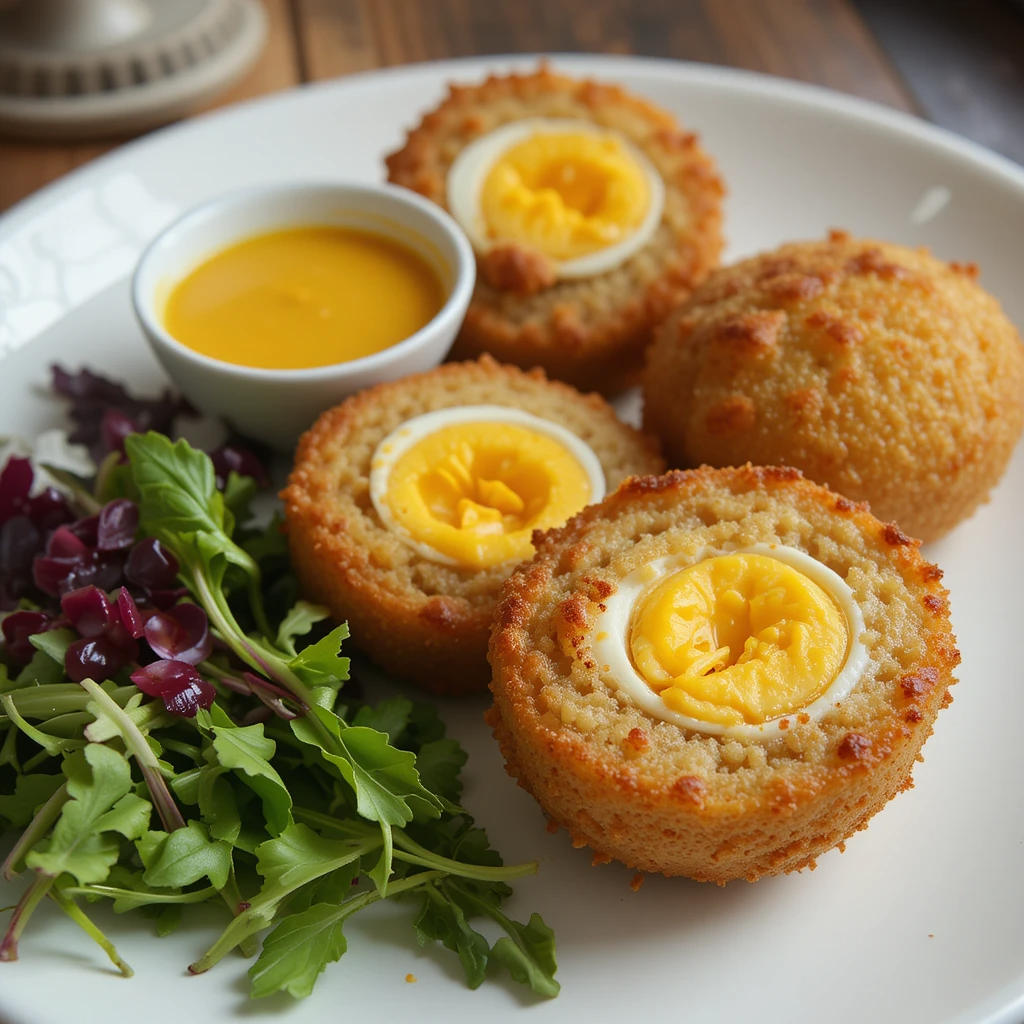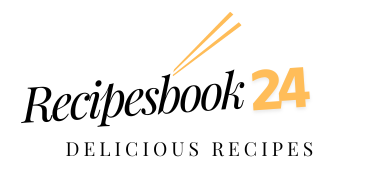Have you ever craved a snack that’s crispy, satisfying, and packed with hearty flavor all in one bite? If so, you’re going to fall head over heels for this homemade Scotch eggs recipe. Whether you’re planning the ultimate picnic, looking for a crowd-pleasing appetizer, or simply craving a taste of classic British pub food at home, these golden, sausage-wrapped eggs deliver pure comfort with every crunchy bite.
I’ll walk you through exactly how to make Scotch eggs the easy way — with tips for getting that perfect golden breadcrumb coating and options for soft or hard-boiled centers depending on what you love most. Get ready to create a crave-worthy dish you’ll want to enjoy again and again!
Key Benefits
If you’ve never made homemade Scotch eggs before, you’re in for a real treat! Beyond being absolutely delicious, there are so many reasons why this easy Scotch eggs recipe deserves a spot in your regular rotation.
Table of Contents
Here’s why you’ll instantly love it:
- Incredibly Satisfying: With a hearty sausage wrap and a perfectly cooked egg inside, every bite is rich, flavorful, and protein-packed — making it perfect for everything from brunch spreads to picnic food ideas.
- Crispy and Golden Every Time: Thanks to the crunchy breadcrumb coating, these Scotch eggs come out beautifully crisp, whether you choose to deep-fry or opt for an oven-baked version.
- Surprisingly Easy to Make: Don’t let their impressive appearance fool you! With just a few basic ingredients and some simple steps, you’ll master how to make Scotch eggs even on your first try.
- Versatile for Any Occasion: Serve them warm with a mustard dipping sauce for a cozy dinner, or pack them cold for a traditional British pub food experience during a sunny outdoor picnic.
- Customizable to Your Taste: Whether you prefer spicy sausage, a vegetarian twist, or different doneness levels for the egg (soft or hard-boiled), this recipe easily adapts to your cravings.
Imagine the excitement of slicing into that golden crust to reveal a perfectly cooked egg — it’s pure comfort and celebration in one simple dish!
Ingredients
Before we dive into making these irresistible homemade Scotch eggs, let’s round up everything you’ll need. Trust me, keeping it simple is the secret to achieving that perfect crispy exterior and savory center!

Here’s what you’ll need:
- 6 large eggs – plus 2 extra for coating
- 1 pound (about 450g) sausage meat – pork is classic, but feel free to swap in chicken, turkey, or even plant-based sausage if you prefer
- 1 cup all-purpose flour – for dredging
- 1½ cups breadcrumbs – panko breadcrumbs give an extra crispy crunch, but regular ones work too
- Salt and pepper – to season the sausage and the coating
- Optional spices – a pinch of paprika, mustard powder, or cayenne can add a flavorful kick
- Vegetable oil – for deep-frying (or a light cooking spray if baking)
Optional for serving:
- Mustard dipping sauce or your favorite aioli for that ultimate pub-style experience
Pro Tip: If you’re aiming for a lighter version, you can swap the deep-frying method for an oven-baked Scotch eggs approach — just a little spray of oil and a hot oven will still give you that crave-worthy crispness!
Gathering your ingredients ahead of time makes the whole cooking process smoother and way more enjoyable. Plus, it’s much easier to focus on mastering that golden breadcrumb coating when everything’s ready to go!
How to Make Scotch Eggs
Making homemade Scotch eggs might sound fancy, but once you break it down, it’s honestly a fun and easy process. Think of it like wrapping a little gift — only this one’s full of delicious surprises!
Here’s exactly how to make Scotch eggs step-by-step:

1. Boil the Eggs
- Bring a pot of water to a gentle boil.
- Carefully add 6 eggs and cook for 6 minutes for soft centers or 9 minutes for fully hard-boiled eggs.
- Immediately transfer them to an ice bath to stop the cooking. Once cool, gently peel the eggs and set aside.
Tip: Slightly undercooked eggs are easier to peel — and they finish cooking perfectly when fried or baked!
2. Prepare the Coating Station
- In one shallow bowl, add the flour.
- In a second bowl, beat the 2 extra eggs.
- In a third bowl, pour in the breadcrumbs.
Setting up this “assembly line” makes coating the eggs a breeze!
3. Wrap the Eggs
- Divide the sausage meat into 6 equal portions.
- Flatten each portion into a thin patty.
- Gently wrap the sausage around each peeled egg, smoothing it out so there are no cracks. Try to keep the layer even for consistent cooking.
Pro Tip: Wet your hands slightly — it helps prevent the sausage from sticking!
4. Coat the Eggs
- Roll each sausage-wrapped egg in the flour, tapping off the excess.
- Dip into the beaten egg.
- Finally, roll in breadcrumbs until fully coated.
This triple-coating technique is what gives you that irresistibly crunchy Scotch egg!
5. Cook to Golden Perfection
To Deep-Fry:
- Heat oil in a deep fryer or large skillet to 350°F (175°C).
- Carefully lower the Scotch eggs into the oil and fry for about 5–6 minutes, turning as needed, until golden and crispy.
To Bake (for a lighter option):
- Preheat your oven to 400°F (200°C).
- Place the Scotch eggs on a baking sheet lined with parchment paper.
- Lightly spray them with cooking oil.
- Bake for 25–30 minutes, flipping halfway through, until golden and cooked through.
6. Rest and Serve
- Let the Scotch eggs cool slightly before slicing or serving whole.
- Pair with a tangy mustard dipping sauce for the ultimate flavor boost!
Pro Tips and Variations
Once you get the basics down, making the best Scotch eggs becomes second nature! Here are a few expert tips and creative twists to help you master this classic — and even put your own spin on it.
Pro Tips for Perfect Scotch Eggs
- Chill your boiled eggs: After peeling, pop them in the fridge for a few minutes. A cold egg is easier to wrap in sausage and holds its shape better during cooking.
- Keep the sausage layer thin: Aim for an even, thin layer around the egg — too thick and it may not cook through properly before the breadcrumbs get too dark.
- Seal completely: Make sure there are no gaps where the sausage meets; this prevents the sausage from splitting open while frying or baking.
- Use panko breadcrumbs: For that signature extra-crispy texture, panko is your best friend. It fries up lighter and crunchier than regular breadcrumbs.
- Monitor the oil temperature: If deep-frying, keep the oil steady at around 350°F (175°C). Too hot and the outside will burn before the sausage is cooked through.
Fun and Tasty Variations
- Spicy Scotch Eggs: Mix a little cayenne pepper, chili flakes, or even diced jalapeños into the sausage meat for a fiery kick.
- Herb-Infused: Add fresh chopped herbs like parsley, thyme, or chives into the sausage for a burst of fresh flavor.
- Cheesy Surprise: Insert a small cube of cheddar or mozzarella into the center of the sausage layer before wrapping it around the egg for a melty, gooey bonus!
- Vegetarian Version: Use plant-based sausage alternatives and skip the deep-frying in favor of oven-baking for a lighter, meat-free treat.
- Soft-Boiled Center: Prefer a rich, runny yolk? Just shorten the initial egg boiling time to 5–6 minutes and handle carefully during wrapping.
Quick Tip: Leftover Scotch eggs can be refrigerated for up to 3 days and enjoyed cold — they make an amazing grab-and-go snack or a picnic food favorite!
By playing with flavors and following a few simple tricks, you’ll not only master how to make Scotch eggs but turn them into a signature dish your friends and family will crave.
Serving Suggestions
Once you’ve mastered the art of making homemade Scotch eggs, the fun doesn’t stop there! This dish is incredibly versatile and can be served in so many different ways, whether you’re preparing a cozy dinner or planning a picnic spread. Let’s dive into some delicious serving ideas that will elevate your Scotch egg experience.
Classic Pub-Style
For a traditional approach, serve your Scotch eggs just like they’re served in British pubs. Pair them with:
- Tangy mustard or spicy horseradish sauce for that perfect dip.
- Pickled vegetables like onions, gherkins, or even beetroot to balance out the richness.
- A side of crispy fries or a light salad to round out the meal.
Picnic Perfect
Scotch eggs make an ideal picnic food, portable and packed with flavor. Here’s how to take them on the go:
- Serve them cold: The eggs are just as tasty at room temperature, so you don’t have to worry about reheating. Wrap them in parchment paper for an easy, mess-free snack.
- Add a selection of cheeses: Think cheddar, brie, or a tangy goat cheese to add depth and variety to your picnic spread.
- Fresh fruit: Grapes, apple slices, or even a berry compote add a sweet contrast to the savory Scotch eggs.
Breakfast or Brunch Delight
Want to enjoy Scotch eggs first thing in the morning? Here’s a brunch twist:
- Serve them with a side of sautéed spinach and a dollop of tangy yogurt or sour cream.
- Pair with avocado toast for a balanced, filling meal that will keep you energized all day.
- Top with a drizzle of honey mustard for a sweet and savory contrast that’ll have everyone coming back for more.
Light Dinner or Snack
Looking for a lighter way to serve Scotch eggs? Here’s how:
- Slice them in half and serve them on a bed of mixed greens, dressed with olive oil and lemon juice for a simple, fresh meal.
- Serve with roasted vegetables like carrots, sweet potatoes, or Brussels sprouts for a wholesome, comforting dinner.
- Enjoy with a cold beer or a crisp glass of white wine to balance the rich flavors.
Pro Tip: Scotch eggs are perfect for meal prep. You can make them ahead of time and store them in the fridge for up to 3 days. Just reheat in the oven for a couple of minutes to restore their crispy exterior!
Conclusion
Making homemade Scotch eggs is a rewarding experience that combines crispy, savory, and satisfying flavors in one delicious bite. Whether you’re enjoying them as a classic pub snack, packing them for a picnic, or serving them up as part of a hearty brunch, this recipe is bound to become a favorite in your cooking repertoire.
The best part? Scotch eggs are incredibly versatile — you can tweak the recipe to suit your personal taste, whether that’s with a spicier sausage, a runny soft-boiled center, or adding fresh herbs and cheese to the mix. And with the right tips, you’ll master the perfect crispy coating and golden egg every time.
So next time you’re craving something delicious and comforting, skip the store-bought version and try making your own! Your taste buds will thank you.
Remember: With just a few simple ingredients and some hands-on steps, you’ll create a dish that’s not only impressive but incredibly satisfying to eat.
Enjoy your homemade Scotch eggs and share the joy with family and friends — they’re sure to be a hit wherever they go!

Scotch Eggs Recipe You Will Instantly Love and Crave
Ingredients
Method
- Bring a pot of water to a gentle boil.
- Carefully add 6 eggs and cook for 6 minutes for soft centers or 9 minutes for fully hard-boiled eggs.
- Immediately transfer them to an ice bath to stop the cooking. Once cool, gently peel the eggs and set aside.
- In one shallow bowl, add the flour.
- In a second bowl, beat the 2 extra eggs.
- In a third bowl, pour in the breadcrumbs.
- Setting up this “assembly line” makes coating the eggs a breeze!
- Divide the sausage meat into 6 equal portions.
- Flatten each portion into a thin patty.
- Gently wrap the sausage around each peeled egg, smoothing it out so there are no cracks. Try to keep the layer even for consistent cooking.
- Roll each sausage-wrapped egg in the flour, tapping off the excess.
- Dip into the beaten egg.
- Finally, roll in breadcrumbs until fully coated.
- This triple-coating technique is what gives you that irresistibly crunchy Scotch egg!
- Cook to Golden Perfection
- Heat oil in a deep fryer or large skillet to 350°F (175°C).
- Carefully lower the Scotch eggs into the oil and fry for about 5–6 minutes, turning as needed, until golden and crispy.
- To Bake (for a lighter option):
- Preheat your oven to 400°F (200°C).
- Place the Scotch eggs on a baking sheet lined with parchment paper.
- Lightly spray them with cooking oil.
- Bake for 25–30 minutes, flipping halfway through, until golden and cooked through.
- Let the Scotch eggs cool slightly before slicing or serving whole.
- Pair with a tangy mustard dipping sauce for the ultimate flavor boost!
Notes
- Calories: 320
- Fat: 20g
- Saturated Fat: 7g
- Carbohydrates: 20g
- Fiber: 1g
- Sugar: 1g
- Protein: 15g
- Cholesterol: 180mg
- Sodium: 600mg
FAQs
Here are some of the most common questions I get about making Scotch eggs. If you’re wondering anything specific, this might just answer it!
1. Can I make Scotch eggs ahead of time?
Absolutely! Scotch eggs are a fantastic make-ahead dish. You can prepare them in advance, then store them in the fridge for up to 3 days. Just reheat them in the oven at 350°F (175°C) for a few minutes to restore their crispy exterior. They also make great leftovers for lunch or snacks!
2. How do I get the sausage to stick to the egg?
This can be tricky, but there are a couple of things you can do. First, make sure your boiled eggs are completely chilled before wrapping them in sausage. This makes the wrapping process easier. Also, don’t skip the flour and egg coating — they help the sausage stick. Finally, sealing the edges of the sausage well ensures it stays in place during cooking.
3. Can I bake Scotch eggs instead of frying them?
Yes, you can! Baking is a great option if you’re looking for a lighter version. Simply place the coated Scotch eggs on a baking sheet lined with parchment paper and lightly spray them with oil. Bake them at 400°F (200°C) for 25-30 minutes, turning halfway through to ensure even crispiness.
4. What’s the best way to boil eggs for Scotch eggs?
For soft-boiled eggs, cook them for 6 minutes for a runny yolk or 9 minutes for a hard-boiled yolk. After boiling, immediately transfer them to an ice bath to stop the cooking process. This ensures your eggs stay tender and are easy to peel.
5. Can I use other types of sausage for Scotch eggs?
Yes! While pork sausage is traditional, you can absolutely experiment with different meats or even plant-based sausages. Try chicken sausage for a leaner option, or go for a spicy Italian sausage for added flavor. Just make sure the sausage is flavorful and properly seasoned for the best results.
6. How do I store leftover Scotch eggs?
Store any leftover Scotch eggs in an airtight container in the fridge for up to 3 days. To reheat, place them in the oven at 350°F (175°C) for a few minutes to keep them crispy. They can also be enjoyed cold as a tasty snack!
7. Can I freeze Scotch eggs?
Yes, Scotch eggs freeze wonderfully! After making and cooling them, wrap each one tightly in plastic wrap and store them in a freezer-safe bag or container. To reheat, bake from frozen at 375°F (190°C) for about 30 minutes or until heated through and crispy
